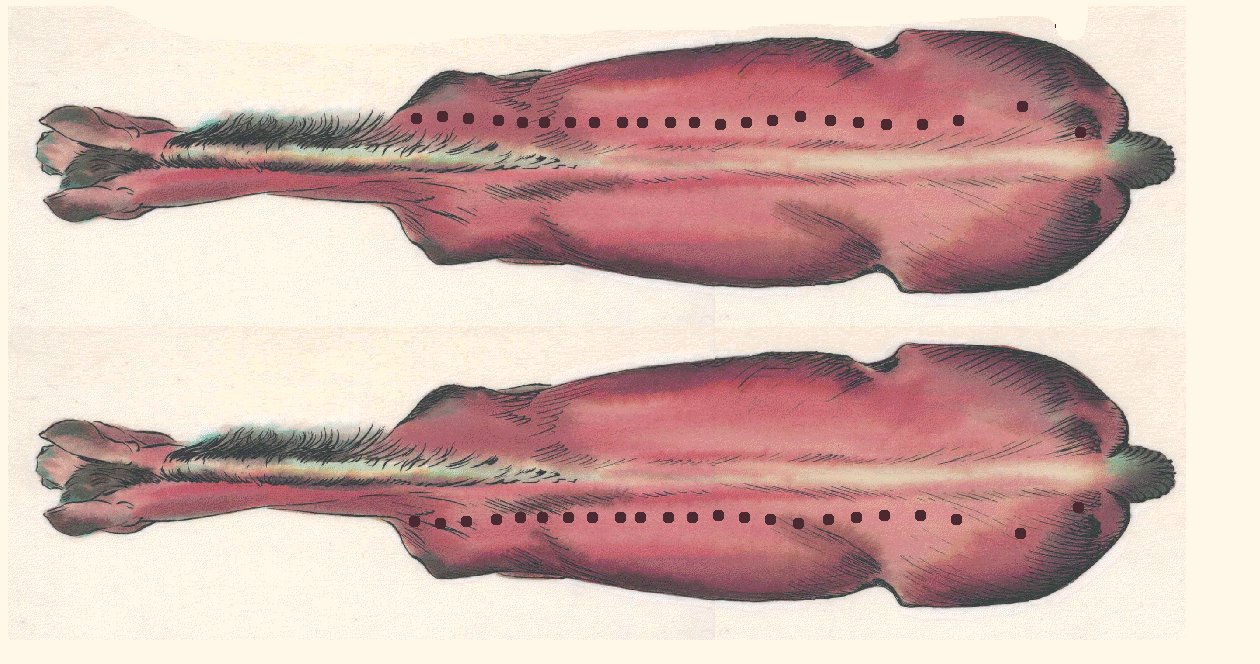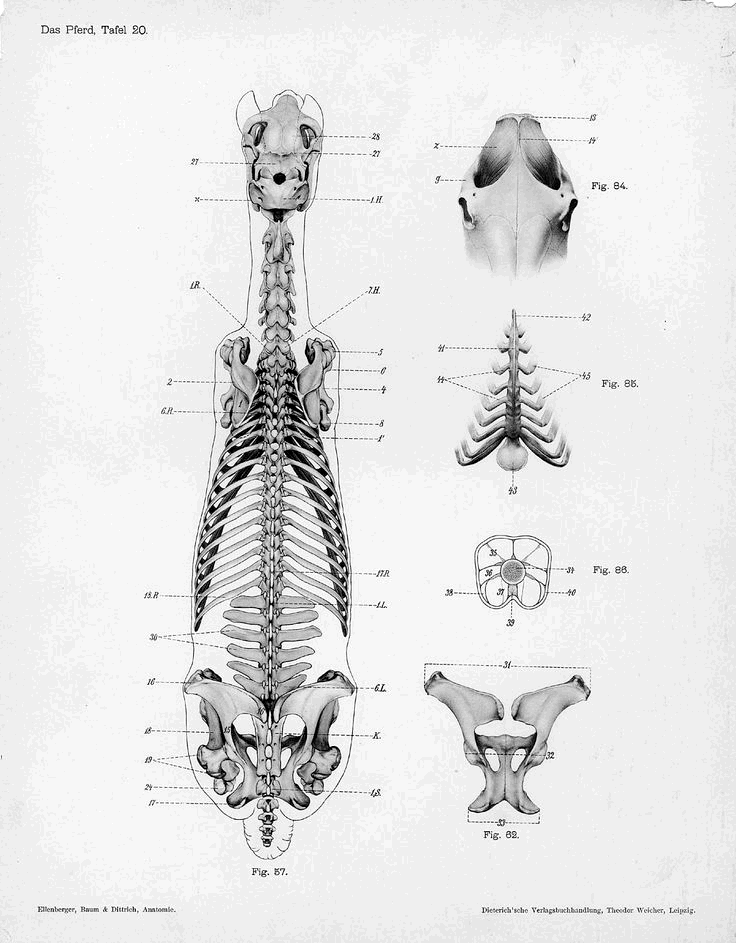Dorn method, Equine Ortho-bionomy, & Acupoints
alignment
in motion
I forget what I was doing but somehow I found this
site about The Dorn
Method. Wow! This is a keeper!
Since it worked so well with me, my first thought was
'What about the horses?!'
So I took this concept and the Equine Ortho-bionomy
concept and have incorporated it into my daily warmup.
At first I thought, "O, I'll only do this a week or
so" but it is so enjoyable, I continue to do it
regularly. The horse's respond immediately with the
biggest release about half way through one side. It
is a wonderful, wonderful thing.
What you'll need
In a word, what you need is a cooperative
horse. In many words:
- a horse that is ok with being ridden at the walk
- the ability to steer the horse with either your
seat or one hand or an area where steering isn't
necessary
- a horse calm enough that you can get out of
position while you're on it's back. You want to
stay up there by balance. There's no hanging on,
so it's really helpful to have good balance yourself
and a horse that's willing to play along.
- some flexibility! (this will improve.)
- optional: ability to ride 'bareback'
I haven't tried this with a saddle.
Theoretically, in a saddle you could at least be able do
the withers and the lumbar area, and if you're
perceptive you could do the areas under the saddle, too,
but I imagine it would take a high degree of
perceptivity/receptivity. If your horse is ok with
bareback (just use a saddle pad to stay clean if you
want!) then I recommend that as long as you can stay
safe.
- optional: a closed arena w/ a track the horse can
follow; a track the horse will follow
I find this
easiest if I can put the horse on a track it
knows. I have a track around the property that
weaves in and out of trees and over things and this
works really well. It is well defined and I can do
minimal steering because the horse has an idea similar
to mine about where we're going.
Alternatively, I can use the
track in the arena although this requires more
steering.
Sometimes I do this on a circle.
If you are a perfectionist, this may not be the
preferable choice -- especially for starting out.
Your horse is more prone to wander a bit and if you've
got some kind of idea in your head about staying on the
circle and keeping straight or any other gremlin in
there, you will end up getting caught up in how to ride
well and that will kind of spoil it.
What do to
Basically, you
attend to each vertebra along the horse's spine.
You can do one side first and then the other side, or you
can do the front end on both sides and then the back end on
both sides. Your choice!
- Hop on!
- Head onto your (mostly straight)
track.
- To do the right side of the horse, (track
right if you're in a ring or round pen)
- hold your reins either in the left hand -or- hold the left rein w/ loose contact and the
right rein long
- You'll begin at the withers and work your way along the right side of the
horse's spine, about 1/4" from the midline, using your right hand, from the
withers to the tail.
- For points in front of the lumbar, you'll bring
attention to the point as the left foreleg contacts
the ground and swings back for 10 strides or more.
- For points along the lumbar and in the sacrum,
you'll bring attention to the point as the left hind
leg contacts the ground and swings back for 10
strides or more.
- As you work your way back from the withers, you
will get to a point where you've got to put your
hand behind you. To do this, swivel through
your spine as if you're doing a right hand turn or a
position right. This may have your horse
thinking it's time to turn right! So here's
where your steering will matter. If nothing
else, hang onto the left rein. If it totally falls
apart, skip the area behind you until your horse is
more on board with what you're doing.
- To do the left side, switch reins (switch to the
left track if you're in a ring or round pen) and use your left
hand along the left side of the horse's back from
withers to tail.
For me, this now takes about 2 laps/side. When
you start out, let it take longer, of course, and be happy
with even doing a little bit. The horse will enjoy it
and so will you and it will be easy and natural to add in
more points as the comfort levels increase.
If you're doing this in a round
pen, circle to the
right to do the right side to make it easier on yourself
and your horse. Eventually you can circle left and do
the right side; however, it takes a bit more coordination.

the original image was found on http://www.ucd.ie/vetanat/images/image.html
and provided by Prof. Pat McCarthy (Australian). I
would love to find the original book this illustration came
out of!
To bring
attention to a point: (using the right side as an
example)
There are two ways to bring attention to a
point. One is the way utilized by the Dorn method and
the other is the one utilized by Equine Ortho-bionomy.
If you use the Dorn method, check out their website and
maybe get their book.
- For the thoraces, place your right hand on the horses
back about
1/4" to the right of the spiny process,
starting at in front of the withers.
- As the left foreleg swings back, bring
attention to the place where you've got your
hand.
- In the Dorn method, which is closer to
chiropractic, there is the idea of physically
guiding the body into alignment. I don't
recommend this unless you're a chiropractor
because this isn't your body. If you
do press into this area, only do so with the
intention to 'wake up' this part of the
horse's body. You've got more contact,
but you're not moving bones into place or
anything. The horse's body will move
the bones if that's the correct thing for
the horse's body. (I know, that sounds
weird until you get used to it happening.)
- In Equine Ortho-bionomy, your awareness is all
you need; however, the hand in place helps you to
focus and get information about what's
happening in the horse's body. And you
will actually rhythmically increase the pressure
to heighten that awareness.
In your
mind's eye, create a picture
or sense or awareness of whether or not the wing of
the vertebra
is high or low on the right side. It doesn't
matter if you see anything or actually feel
anything. Simple trust you've got a
correct idea and then pay attention to what
happens. What happens will provide you
feedback about how correct your idea is.
If
the wing of the vertebra is high, provide slightly more physical contact while emphasizing in
your mind that it is high.
If it is low,
provide slightly more physical contact while emphasizing in your
mind that it is low.
This is the Ortho-bionomy
concept of supporting the pattern that is in
place. It provides feedback to the
nervous system and the nervous system
self-corrects the horse's body. (Yeah
-- I just skimmed over a lot of things about
how that works...)
- Do this for at least 10 strides. Count
and attend each time the left foreleg swings back
for 10 steps of the left foreleg.
- As you work your way along the spine, you
will be going into more of a position
right. At some point you'll have to put
your right hand behind you. When this
happens, you will want to have swiveled through
your spine so that your chest is pointing to the
right.
- For the lumbar and sacrum, continue placing
your hand about 1/4" from the midline
- As the left hind leg swings back, bring
attention to the place where you've got your
hand.
- Do this for at least 10 strides. Count
and attend each time the left hind leg swings back
for 10 steps of the left hind leg. This
occurs every time your right hip goes back.
- By the time you get to the sacrum, you will
most likely be behind vertical and unless you're a gymnast
your legs will probably be ahead -- this is where
you want a cooperative horse! This is a little
precarious anyway, so you don't want your horse
being ornery to make it even more risky. Be
careful.
Some notes:
Here's a picture of a horse's spine, from above, to
give you an idea of where the bones are. I have
noticed on my own horse's that there's not a lot of room
between the shoulder and the spiny process. I imagine
that indicates the chest is 'low' in the shoulder girdle
and we need some crossing over exercises to help with
that.
As you're doing this, you are also releasing muscles
and activating Acu points.
The muscles involved are the longissimus dorsi, which
runs the length of the back, and all the many
intertransversarii and interspinales muscles. These
are tiny muscles that help with the alignment and
articulation of the vertebra and they are the dickens
when they are tight. When you get into the sacrum,
the glutes benefit, too. The benefit comes from the gentle
press/release done in rhythm to the walk. Releasing
the muscles allows the bones to articulate in a more fluid
and coordinated manner.
The press/release done in rhythm to the walk also
activates Bladder Meridian acupoints along the
spine. Activating the Bladder meridian
acupoints will help to clear the Bladder meridian -- always
a good idea to have a clear and flowing meridian, AND since
it's the Bladder meridian and the Bladder meridian has Shu
Points, you're giving the horse a whole body tune-up.
To explain, the Shu points relate to both the meridians and
their physical organ name sakes. (The meridians cover
a lot more than the physical organs.) So when you
clear BL13, you've helped to clear out the Lung meridian
AND the horse's lungs. As you work along the spine,
you'll do the Pericardium, Heart, Gallbladder, Liver,
Spleen, Stomach, Bladder and Kidney. (Also some other
'conceptual' areas ...)
Soooo -- this is a winner, folks. Give it a try
and let me know how it goes for you!
 |
 |
|
The original image was found on digicoll.library.wisc.edu;
text:
Das Pferd, Tafel 20 Other Title: The horse Dittrich,
Herman These are images of a dorsal view (from above) of a
whole skeleton, a dorsal view of the caudal part of the
skull, a ventral view of the sternum, a view of a
transverse section of the tail and dorsal view of the
pelvis displaying primarily components of the axial
skeleton Ellenberger, Wilhelm, Hermann Baum, and Hermann
Dittrich. 1898. Handbuch der Anatomie der Tiere für
Künstler. Leipzig: Dieterichsche Verlagsbuchhandlung.
|
The original image is at http://www.horse-doc.coml |
And remember, I'm always available for
appointments!
Cheers!
L
|




![Centered Riding Today: An Informal Talk by Sally Swift [VHS]](http://ecx.images-amazon.com/images/I/41Vn6PfhzML._SL125_.jpg)
![Centered Riding with Sally Swift [VHS]](http://ecx.images-amazon.com/images/I/51OSh9kd9iL._SL125_.jpg)






